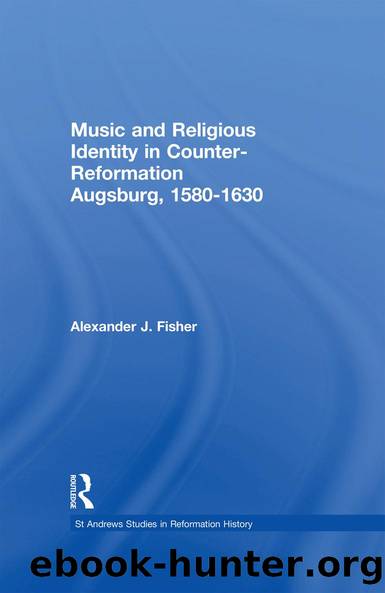Music and Religious Identity in Counter-Reformation Augsburg, 1580-1630 by Alexander J. Fisher

Author:Alexander J. Fisher [Fisher, Alexander J.]
Language: eng
Format: epub
Tags: History, General
ISBN: 9781351916400
Google: uFsPEAAAQBAJ
Publisher: Routledge
Published: 2017-05-15T04:54:13+00:00
Presumably the âvigil booksâ would have been copies of the Breviary, providing appropriate chants and texts for certain Offices celebrated by the confraternity. The donation of a regal in 1597 suggests, however, that the group may have performed more than just plainchant on occasion.
Since commoners as well as educated lay and clergy joined groups like the Trinity Confraternity by the early seventeenth century, German songs as well as Latin music would have found a place in their devotional activities. The six published songsheets by Johann Haym von Themar (d. 1593), a choir-vicar at Augsburg Cathedral and a member of the group, demonstrate this coexistence of Latin- and German-texted music. On the one hand we find the Litaniae Textus triplex (1582), a set of three simple polyphonic Latin litanies for Christ, the Virgin Mary and saints designed for pilgrimages (discussed in greater detail in Chapter 7); but the remainder of his songs set German texts, like the Christenliche Catholische Creutzgesang (1584), consisting of German paraphrases of the Our Father, Ave Maria and Apostlesâ Creed âfor the praise and honour of God, and of the lay, praiseworthy brotherhood of the Holy Mountain in the Cathedral of Our Lady in Augsburg; and also for the benefit of other Catholic Christians when one processes with the cross, or sings in churchâ (see Example 5.2).43 This print in particular enjoys a close relationship to the rituals of the Trinity Confraternity itself. None of the three songs is among the ten approved by Bishop Marquard von Berg in the 1580 Ritus ecclesiastici Augustensis Episcopatus (see p. 113); however, in 1587 Pope Sixtus V had granted indulgences to members of the Trinity Confraternity for reciting the Our Father, Ave Maria and Apostlesâ Creed, precisely the texts of Haymâs Creutzgesang, during pilgrimages and on feasts of Jesus and the Virgin Mary.44
Example 5.2 Haym, Vater unser der du bist, from Christenlich Catholische Creutzgesang (1584)
Download
This site does not store any files on its server. We only index and link to content provided by other sites. Please contact the content providers to delete copyright contents if any and email us, we'll remove relevant links or contents immediately.
Aircraft Design of WWII: A Sketchbook by Lockheed Aircraft Corporation(32139)
The Great Music City by Andrea Baker(30797)
Call Me by Your Name by André Aciman(19928)
The Art of Boudoir Photography: How to Create Stunning Photographs of Women by Christa Meola(18414)
The Secret History by Donna Tartt(18213)
Shoot Sexy by Ryan Armbrust(17563)
Plagued by Fire by Paul Hendrickson(17119)
Portrait Mastery in Black & White: Learn the Signature Style of a Legendary Photographer by Tim Kelly(16877)
Adobe Camera Raw For Digital Photographers Only by Rob Sheppard(16805)
Photographically Speaking: A Deeper Look at Creating Stronger Images (Eva Spring's Library) by David duChemin(16504)
Ready Player One by Cline Ernest(14023)
Pimp by Iceberg Slim(13798)
Bombshells: Glamour Girls of a Lifetime by Sullivan Steve(13698)
The Goal (Off-Campus #4) by Elle Kennedy(13207)
Art Nude Photography Explained: How to Photograph and Understand Great Art Nude Images by Simon Walden(12858)
Kathy Andrews Collection by Kathy Andrews(11340)
The Priory of the Orange Tree by Samantha Shannon(8631)
Thirteen Reasons Why by Jay Asher(8466)
The remains of the day by Kazuo Ishiguro(8410)
